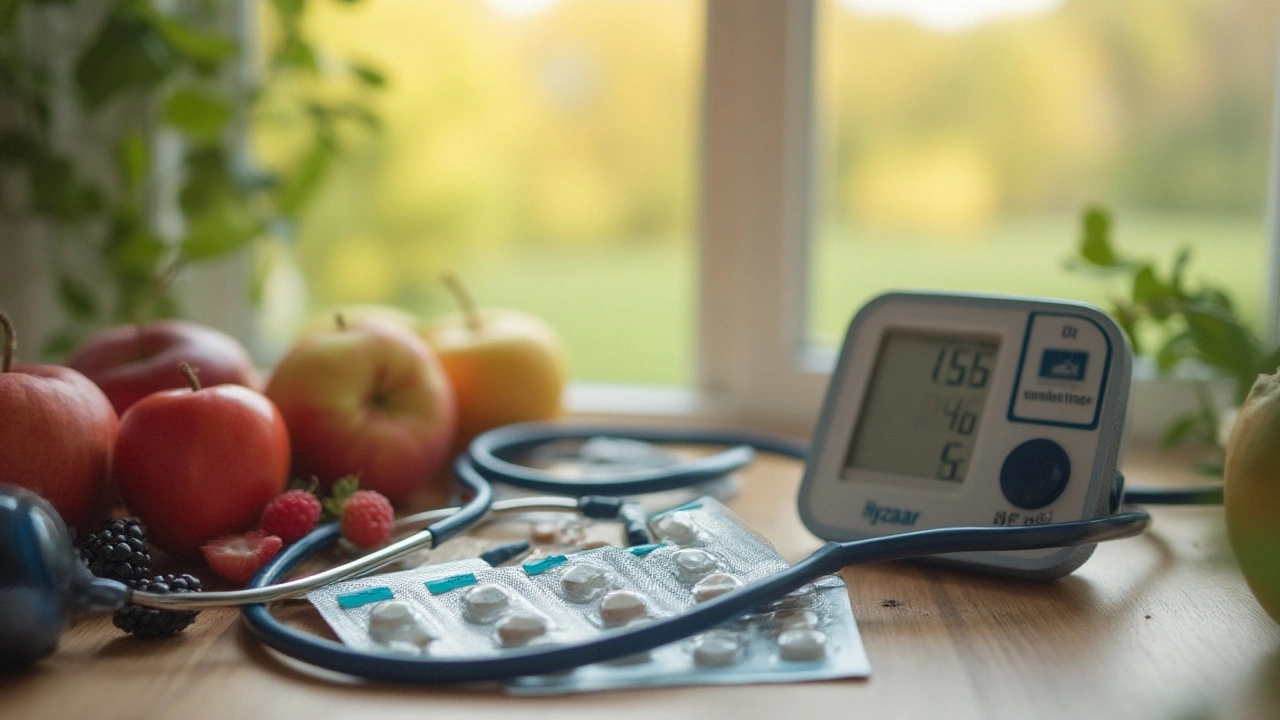Did you know there’s a prescription pill that can quietly tackle high blood pressure using a smart tag team inside? Hyzaar does exactly that, and it’s been changing the routine for folks watching their numbers climb higher than the doctor likes. High blood pressure doesn’t make much noise at first. But keep ignoring it, and you’re facing risks for serious stuff—stroke, heart failure, messed-up kidneys—that don’t play around. Hyzaar stands out not because it’s brand-new, but because it’s designed to pack a one-two punch by using two old pros together: losartan and hydrochlorothiazide. There’s no cloak-and-dagger; you’ve probably heard both names separately. But when they join forces, they make blood pressure drop and help protect the heart for the long haul.
What is Hyzaar and How Does It Work?
Hyzaar might sound like it belongs in a sci-fi story, but at the pharmacy, it’s a trusty combo pill for people dealing with high blood pressure. The two active ingredients, losartan potassium and hydrochlorothiazide, each come with their own strengths. Losartan is called an angiotensin II receptor blocker, or ARB for short. In simple terms, it stops a chemical in your body that normally tells blood vessels to narrow. Less narrowing means less pressure inside your arteries, so the numbers on your BP monitor slide down. On the other hand, hydrochlorothiazide is a diuretic, which folks usually call a water pill. It prods your kidneys to flush out salt and water, which drops the amount of fluid running through your veins and lightens the load on your heart.
This tag team approach means Hyzaar tackles blood pressure from two directions at once: relaxing the blood vessels and lowering the fluid volume. That dual action turns out to be more effective—and often better tolerated—than trying to max out the dose of just one med. Doctors often reach for Hyzaar when single meds aren’t cutting it or when a person is at higher risk of heart attack, kidney trouble, or stroke. The pill comes in different strengths, typically starting with losartan 50mg paired with hydrochlorothiazide 12.5mg, but higher dosages are around for tough cases.
The science is solid: A big review back in 2011 showed ARB-diuretic combos lowered systolic blood pressure (that’s the top number) by about 20-25 mmHg and diastolic pressure (the bottom number) by 10-15 mmHg on average. That’s the difference between heading for medication or celebrating better check-up numbers. Hyzaar also brings another bonus—the ARB side (losartan) can actually slow kidney problems linked to diabetes. It’s a big deal for people juggling both conditions.
Common Uses and Who Benefits Most from Hyzaar
You’ll most often see Hyzaar prescribed when someone’s blood pressure stays too high even after trying other medicines. But it’s also got a special spot for patients at higher risk—think older adults, people with diabetes, kidney disease, or those who’ve had heart issues in the past. This isn’t just about heart attacks. Hyzaar works in the background, helping to stop small strokes, heart failure, and damage to tiny arteries in your eyes and kidneys. By the way, nearly 119 million adults in the U.S. have high blood pressure, according to recent CDC data. That’s almost half, so we’re talking about a problem affecting more people than not.
Doctors sometimes pick Hyzaar for people whose blood pressure pops up after a salty meal, or for those who need to shed extra fluid. The combo makes it easier to control both “silent” numbers and the puffiness or swelling that comes with extra fluid. For some, it even drops the number of pills to take. Let’s face it, nobody loves a long med list taped to their fridge.
But this isn’t a magic “one size fits all” pill. It’s not for folks with really low blood pressure, certain kinds of kidney or liver problems, or if you’re allergic to sulfa drugs (since hydrochlorothiazide is a relative). Pregnant women should stay away—the losartan piece can affect the baby. And if you’ve got gout, the diuretic part can set off flare-ups. Hyzaar is just for adults; no kid-sized versions.

Possible Side Effects and How to Handle Them
No medicine is perfect, and Hyzaar has its quirks and potential headaches, too. The most common side effect? Peeing more often. That’s the hydrochlorothiazide at work, flushing out those extra fluids. Don’t be surprised if you’re making extra trips to the restroom, especially right after you first start the pill or adjust your dose. Drink plenty of water, but not too much—you don’t want to wash away too many minerals, either.
Low potassium can be a bigger concern. While losartan may help your body hold onto potassium, hydrochlorothiazide can drain it. Watch out for muscle cramps, weakness, or strange heartbeats. Potassium-rich foods like bananas or oranges help, but check with your doctor before grabbing any supplements. If you’re also popping medicines for cholesterol or taking anti-inflammatories like ibuprofen, let your doctor know—those mixes can mess with your kidneys or blood minerals.
Other common bumps in the road—dizziness when you stand up too fast, tiredness, or a lingering dry cough (though that’s more common with a different blood pressure pill group called ACE inhibitors). About 2% of users feel dizzy or lightheaded, according to clinical trials. Tell your doctor if you’re feeling off balance. Rare but serious risks include allergic reactions, sharp drops in blood pressure, changes in heartbeat, or worsening kidney function. Stay sharp for swelling in your face, lips, or throat, as that needs immediate attention. Most issues show up early, but anyone starting Hyzaar should get labs checked a month or so in to watch for quiet changes.
| Side Effect | Chance (%) |
|---|---|
| Increased urination | 7 |
| Dizziness | 2 |
| Muscle cramps | 2 |
| Low potassium | 1 |
| Allergic reaction | <1 |
Don’t just stop Hyzaar cold turkey, either. Your pressure could spike, and that defeats the whole point. Keep doctors in the loop, stick with scheduled checkups, and ask questions if something feels off. People with diabetes should check their sugar levels a little more often at the start, since diuretics sometimes nudge those numbers up or down unpredictably.
Dosage, What to Expect, and Tips for Safer Use
Most folks start with the lower dose option—losartan 50mg and hydrochlorothiazide 12.5mg once daily. Doctors are likely to tweak this after a couple weeks, depending on how well your numbers settle in. The highest typical dose maxes out at losartan 100mg and hydrochlorothiazide 25mg once per day, but going higher doesn’t always mean better. A lower dose means fewer risks for side effects.
Hyzaar works best when you take it roughly the same time every day—makes it easier for your body to keep things steady. Mornings are usually best, since you’ll be awake to deal with any extra bathroom runs. Taking it with food is fine, but it isn’t picky about being with breakfast or on an empty stomach. If you miss a dose, don’t double up. Just take the next one like normal and go on.
You might notice results within a week or two, but the best blood pressure response usually settles in after about a month. Don’t judge too quickly—give it time. And get in the habit of checking your pressure at home, if you can. Keeping a log helps spot patterns and makes doctor visits a lot more helpful. Hyzaar won’t cure high blood pressure, but it helps keep it in check. If you feel flushes, faint, or your blood pressure dips too low, mention it. Sometimes just adjusting when you take it or how much you drink handles most hiccups.
Here are a few tips to get the best from Hyzaar:
- Track your blood pressure a couple times a week—write the numbers down.
- Watch for swelling in ankles, feet, or hands, or any sudden weight gain.
- Eat foods rich in potassium, like sweet potatoes, spinach, or beans—but don’t overdo it.
- If it’s hot outside or you’re sweating a lot, drink extra fluids (but check with your doctor for your specific needs).
- Make a checklist for your daily medicines—taking Hyzaar at the same time builds a routine.
- Double-check every new medicine you start with your pharmacist. Some cold and allergy pills can raise blood pressure or mess with Hyzaar.
- If you see a new doctor, always mention you’re on Hyzaar, since it changes how your kidneys react to other meds.
The best results come when this medicine is part of your larger healthy lifestyle: watch the salt, move your body often, quit smoking, and keep doctor’s visits on the calendar. The more effort you put into lifestyle tweaks, the less you might even need medicine in the long run.

Frequently Asked Questions and Practical Answers
If this is your first time hearing about Hyzaar, chances are you’ve got a lot of questions, maybe even some worries. People often wonder if it’s safe to stay on for years, or if there are long-term downsides. Here’s the scoop: Studies show that people on ARB-diuretic combos like Hyzaar usually do well for years, especially if they keep a close eye on blood tests and check blood pressure regularly. There’s no evidence the medicine itself “wears out” or stops working over time, unless your overall health takes a turn or you add new medicines that mix things up.
Another big question: is it safe to drink alcohol with Hyzaar? Moderate alcohol (think: one drink for women, two for men, max) is usually okay, but heavy drinking makes blood pressure harder to control and can dehydrate you further. If you’re planning surgery or a dental procedure, let your provider know ahead of time—you might need to pause Hyzaar for a day or two, especially if you’ll be fasting or bleeding more than usual.
People sometimes ask if they can buy Hyzaar as a generic. Yes—there’s a generic version called losartan potassium and hydrochlorothiazide. It works just as well as the name brand, and switching won’t affect how you feel or your dose. One thing to know: these pills usually look different, so don’t panic if you refill and they change shape or color.
For people who notice muscle cramps or feel weak, ask your doctor about checking potassium and sodium levels. If you take supplements or use herbal teas, double-check that none have weird interactions. Grapefruit is generally okay (unlike with some other blood pressure pills), but always ask if you’re unsure. Traveling? Stash your pills in your carry-on bag, and bring a little water bottle to stay hydrated on the road.
You might wonder if Hyzaar makes you lose weight. Not really. Any weight change from losing fluid is just temporary—it doesn’t replace diet and exercise. And if you’re pregnant, planning to get pregnant, or breastfeeding, talk with your doctor about safer options. Hyzaar is not safe in pregnancy.
When it comes to blood pressure control, Hyzaar is like a tool in your toolbox—not a quick fix. Its real value comes from steady use, patient tracking, and being honest with healthcare teams about side effects or concerns. Don’t let the fear of the unknown get in the way—when taken right and monitored well, Hyzaar has helped millions keep their blood pressure where it should be and dodge the bad news that high blood pressure can bring. Just like with any tool, it works best when paired with the right habits and regular, real-world experience. If you’re ever in doubt, or just want to double-check your game plan, ask your doctor. They’ll help you find a setup that fits you, no matter how winding the road to healthy blood pressure might seem.




